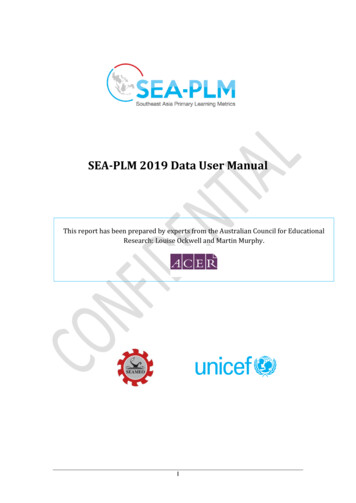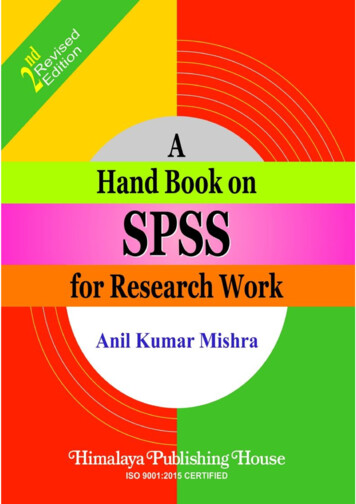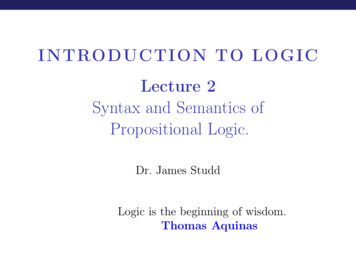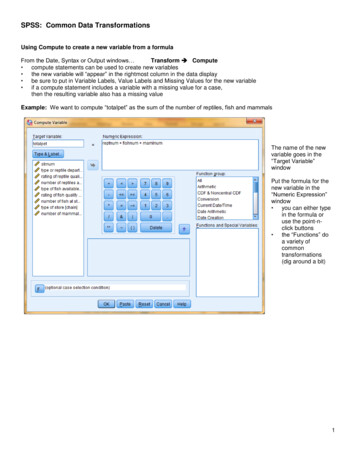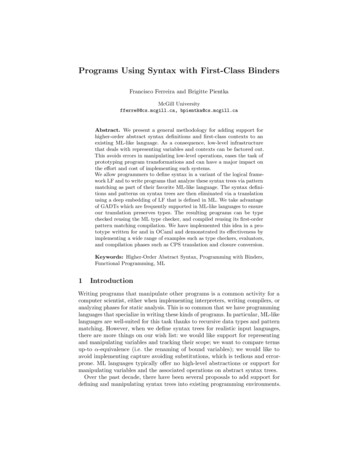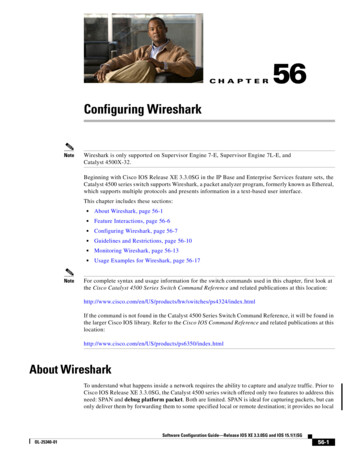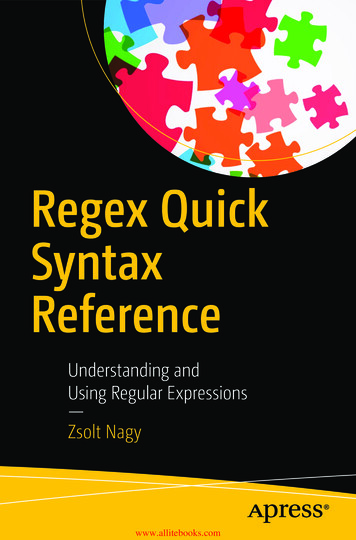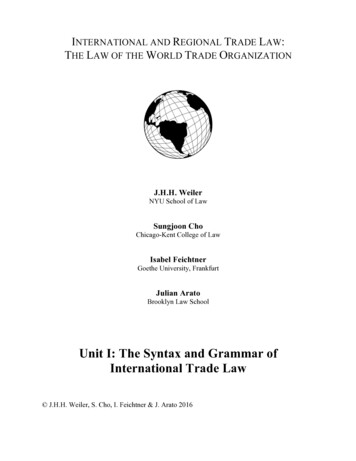
Transcription
INTERNATIONAL AND REGIONAL TRADE LAW:THE LAW OF THE WORLD TRADE ORGANIZATIONJ.H.H. WeilerNYU School of LawSungjoon ChoChicago-Kent College of LawIsabel FeichtnerGoethe University, FrankfurtJulian AratoBrooklyn Law SchoolUnit I: The Syntax and Grammar ofInternational Trade Law J.H.H. Weiler, S. Cho, I. Feichtner & J. Arato 2016
International and Regional Trade Law:The Law of the World Trade OrganizationUnit I: The Syntax and Grammar of International Trade LawTable of Contents1. Introductory Note . 31-1. General Remark on the Teaching Materials . 31-2. Supplementary Reading . 31-3. Useful Links . 42. The Economics of International Trade . 52-1. Comparative Advantage . 52-2. Paul R. Krugman, What Do Undergrads Need To Know About Trade? . 73. International Trade Law and the WTO . 123-1. Stages of Economic Integration . 123-2. Introduction to the WTO . 143-3. Telos of the WTO . 41Legal Texts. 41Case Law: US–Section 301 . 443-4. Globalized Trade and its Discontents . 53The Nationalist / Populist Challenge . 54Donald Trump, Speech on International Trade. 54A Free Trader’s “Response” . 61Trade and Environment. 63Trade and Human Rights . 68Gender Issues and International Trade . 74Trade and Development . 78Optional Reading . 80Simon Lester, Is the Doha Round Over?: The WTO’s Negotiating Agenda for 2016 andBeyond . 80ii
1. Introductory Note1-1. GENERAL REMARK ON THE TEACHING MATERIALSThe focus of these teaching materials is on primary sources – mainly the relevant legal texts andAppellate Body and panel reports. This is explained by our method to teach WTO law throughthe careful reading and analysis of cases. Because your reading time is limited, this teachingmethod entails that we cannot aim at comprehensiveness in the teaching materials, that we cannotnote and comment on each development in the law. Rather it is our aim to teach you how to teachyourself the law of international trade. Therefore we will try to guide your reading throughout thematerials – more so in the beginning and less in further units. While the mandatory part of theteaching materials tries to cover all important aspects of the WTO and its law, the optionalreading will point to further developments in the law and, in addition, shall be an aid tocontextualize the issues that are raised in the mandatory reading. In the section “OptionalReading” we therefore include case notes and reproduce or point to significant scholarlycontributions.When preparing for class and when in class it is important that you always have the PrimarySources at hand. The texts of all WTO Agreements can be found on the WTO’s website underhttp://www.wto.org/english/docs e/legal e/legal e.htm; all WTO panel and Appellate Bodyreports can be found under http://www.wto.org/english/tratop e/dispu e/dispu status e.htm.With respect to WTO texts from the WTO’s official website we would like to add a note ofcaution. When reading these texts keep in mind that they represent a certain view put forward bythe organization, they are the WTO’s ‘propaganda’ if you want.If you discover any dead links or mistakes in these teaching materials, and also if you havesuggestions for their improvement, please let us know.1-2. SUPPLEMENTARY READINGFor (optional) supplementary reading that will give you a more complete overview of the state ofthe law we recommend the following treatises:Peter van den Bossche & Werner Zdouc, The Law and Policy of the World Trade Organization,2013.Raj Bhala, Modern GATT Law. A Treatise on the General Agreement on Tariffs and Trade, 2013.Michael J. Trebilcock, Robert Howse, & Antonia Eliasson, The Regulation of InternationalTrade, 4th ed. 2013.John H. Jackson, William J. Davey, Alan O. Sykes, International Economic Relations: Cases,Materials, and Text on the National and International Regulation of Transnational EconomicRelations, 6th ed. 2013John H. Jackson, The World Trading System, 2nd ed. 1997.3
At the beginning of each unit we will point you to the relevant sections of these books. If youwish you can read them in conjunction with the teaching materials to get a complete overviewover the state of the law.For Unit I we suggest the following sections for supplementary reading:Van den Bossche & Zdouc, Chapter 1, pp. 1-73.Trebilcock, Howse & Eliason, pp. 1-53.Jackson, Davey, & Sykes, Chapter 1, pp. 1-64.Jackson, Chapters 1 and 2, pp. 1-78.1-3. USEFUL LINKSYou might find the following websites useful to find primary sources and also secondaryliterature:www.wto.orgOn the official website of the WTO you find i.a. the official documents of the WTO, the officialdocuments issued under the GATT 1947, news about the organization and publications of theWTO, including the WTO Analytical Index, an article by article commentary on the agreements.www.worldtradelaw.netOn this website – which is in part publicly accessible and in part only accessible for subscribers -you find i.a. the case law of the WTO, case commentaries, scholarly articles and a guide.htmlThis WTO and GATT Research Guide of the NYU law library is a good starting point forresearch on international trade law.http://www.ali.org/index.cfm?fuseaction projects.proj ip&projectid 10The American Law Institute publishes on this website joint studies by legal experts andeconomists that analyze WTO Appellate Body and panel reports.4
2. The Economics of International Trade2-1. COMPARATIVE ADVANTAGEFrom The Economics HABETIC.CFM?TERM COMPARATIVEADVANTAGE#COMPARATIVEADVANTAGEPaul Samuelson, one of the 20th century’s greatest economists, once remarked that the principleof comparative advantage was the only big idea that ECONOMICS had produced that was bothtrue and surprising. It is also one of the oldest theories in economics, usually ascribed to DAVIDRICARDO. The theory underpins the economic case for FREE TRADE. But it is oftenmisunderstood or misrepresented by opponents of free trade. It shows how countries can gainfrom trading with each other even if one of them is more efficient – it has an ABSOLUTEADVANTAGE – in every sort of economic activity. Comparative advantage is about identifyingwhich activities a country (or firm or individual) is most efficient at doing.To see how this theory works imagine two countries, Alpha and Omega. Each country has 1,000workers and can make two goods, computers and cars. Alpha’s economy is far more productivethan Omega’s. To make a car, Alpha needs two workers, compared with Omega’s four. To makea computer, Alpha uses 10 workers, compared with Omega’s 100. If there is no trade, and in eachcountry half the workers are in each industry, Alpha produces 250 cars and 50 computers andOmega produces 125 cars and 5 computers.What if the two countries specialise? Although Alpha makes both cars and computers moreefficiently than Omega (it has an absolute advantage), it has a bigger edge in computer making.So it now devotes most of its resources to that industry, employing 700 workers to makecomputers and only 300 to make cars. This raises computer output to 70 and cuts car productionto 150. Omega switches entirely to cars, turning out 250.World output of both goods has risen. Both countries can consume more of both if they trade, butat what PRICE? Neither will want to import what it could make more cheaply at home. So Alphawill want at least 5 cars per computer, and Omega will not give up more than 25 cars percomputer. Suppose the terms of trade are fixed at 12 cars per computer and 120 cars areexchanged for 10 computers. Then Alpha ends up with 270 cars and 60 computers, and Omegawith 130 cars and 10 computers. Both are better off than they would be if they did not trade.This is true even though Alpha has an absolute advantage in making both computers and cars.The reason is that each country has a different comparative advantage. Alpha’s edge is greater incomputers than in cars. Omega, although a costlier producer in both industries, is a less expensivemaker of cars. If each country specialises in products in which it has a comparative advantage,both will gain from trade.In essence, the theory of comparative advantage says that it pays countries to trade because theyare different. It is impossible for a country to have no comparative advantage in anything. It maybe the least efficient at everything, but it will still have a comparative advantage in the industry inwhich it is relatively least bad.5
There is no reason to assume that a country’s comparative advantage will be static. If a countrydoes what it has a comparative advantage in and sees its INCOME grow as a result, it can affordbetter education and INFRASTRUCTURE. These, in turn, may give it a comparative advantagein other economic activities in future.6
2-2. PAUL R. KRUGMAN, WHAT DO UNDERGRADS NEED TO KNOW ABOUTTRADE?83 Am. Econ. Rev. No. 2, 23, 23-26 (1993)Few of the undergraduates who take an introductory course in economics will go on tograduate study in the field, and indeed most will not even take any higher-level economicscourses. So what they learn about economics will be what they get in that first course. It is nowmore important than ever before that their basic training include a solid grounding in theprinciples of international trade.I could justify this assertion by pointing out that international trade is now moreimportant to the U.S. economy than it used to be. But there is another reason, which I think iseven more important: the increased perception among the general public that international trade isa vital subject. We live in a time in which Americans are obsessed with internationalcompetition, in which Lester Thurow's Head to Head is the non-fiction best-seller and MichaelCrichton's Rising Sun tops the fiction list. The news media and the business literature aresaturated with discussions of America's role in the world economy.The problem is that most of what a student is likely to read or hear about internationaleconomics is nonsense. What I want to argue in this paper is that the most important thing toteach our undergrads about trade is how to detect that nonsense. That is, our primary missionshould be to vaccinate the minds of our undergraduates against the misconceptions that are sopredominant in what passes for educated discussion about international trade.I. The Rhetoric of Pop InternationalismAs a starting point, I would like to quote a typical statement about internationaleconomics. (Please ignore the numbers for a moment.) Here it is: "We need a new economicparadigm, because today America is part of a truly global economy (1). To maintain its standardof living, America now has to learn to compete in an ever tougher world marketplace (2). That'swhy high productivity and product quality have become essential. (3). We need to move theAmerican economy into the high-value sectors. (4) that will generate jobs (5) for the future. Andthe only way we can be competitive in the new global economy is if we forge a new partnershipbetween government and business (6)."OK, I confess: it’s not a real quotation. I made it up as a sort of compendium of popularmisconceptions about international trade. But it certainly sounds like the sort of thing one readsor hears all the time- it is very close in content and style to the still-influential manifesto by IraMagaziner and Robert Reich (1982), or for that matter to the presentation made by AppleComputer’s John Sculley at President-elect Clinton’s Economic Conference last December.People who say things like this believe themselves to be smart, sophisticated, and forwardlooking. They do not know that they are repeating a set of misleading cliches that I will dub "popinternationalism."It is fairly easy to understand why pop internationalism has so much popular appeal. Ineffect, it portrays America as being like a corporation that used to have a lot of monopoly power,7
and could therefore earn comfortable profits in spite of sloppy business practices, but is nowfacing an onslaught from new competitors. A lot of companies are in that position these days(though the new competitors are not necessarily foreign), and so the image rings true.Unfortunately, it's a grossly misleading image, because a national economy bears verylittle resemblance to a corporation. And the ground-level view of businessmen is [24] deeplyuninformative about the inherently general-equilibrium issues of international economics.So what do undergrads need to know about trade? They need to know that popinternationalism is nonsense- and they need to know why it is nonsense.II. Common MisconceptionsI inserted numbers into my imaginary quotation to mark six currently popularmisconceptions that can and should be dispelled in an introductory economics course.1. "We need a new paradigm." Pop internationalism proclaims that everything isdifferent now that the United States is an open economy. Probably the most important singleinsight that an introductory course can convey about international economics is that it does notchange the basics: trade is just another economic activity, subject to the same principles asanything else.James Ingram's (1983) textbook on international trade contains a lovely parable. Heimagines that an entrepreneur starts a new business that uses a secret technology to convert U.S.wheat, lumber, and so on into cheap high-quality consumer goods. The entrepreneur is hailed asan industrial hero; although some of his domestic competitors are hurt, everyone accepts thatoccasional dislocations are the price of a free-market economy. But then an investigative reporterdiscovers that what he is really doing is shipping the wheat and lumber to Asia and using theproceeds to buy manufactured goods-whereupon he is denounced as a fraud who is destroyingAmerican jobs. The point, of course, is that international trade is an economic activity like anyother and can indeed usefully be thought of as a kind of production process that transformsexports into imports.It might, incidentally, also be a good thing if undergrads got a more realistic quantitativesense than the pop internationalists seem to have of the limited extent to which the United Statesactually has become a part of a global economy. The fact is that imports and exports are still onlyabout one-eight of output, and at least two-thirds of our value-added consists of non-tradablegoods and services. Moreover, one should have some historical perspective with which tocounter the silly claims that our current situation is completely unprecedented: the United Statesis not now and may never be as open to trade as the United Kingdom has been since the reign ofQueen Victoria.2.-"Competing in the world marketplace": One of the most popular, enduringmisconceptions of practical men is that countries are in competition with each other in the sameway that companies in the same business are in competition. Ricardo already knew better in1817. An introductory economics course should drive home to students the point thatinternational trade is not about competition, it is about mutually beneficial exchange. Even morefundamentally, we should be able to teach students that imports, not exports, are the purpose oftrade. That is, what a country gains from trade is the ability to import things it wants. Exports8
are not an objective in and of themselves: the need to export is a burden that a country must bearbecause its import suppliers are crass enough to demand payment.One of the distressing things about the tyranny of pop internationalism is that there hasbeen a kind of Gresham's Law in which bad concepts drive out good. Lester Thurow is a trainedeconomist, who understands comparative advantage. Yet his recent book has been a best-sellerlargely because it vigorously propounds concepts that unintentionally (one hopes) pander to thecliches of pop internationalism: "Niche competition is win-win. Everyone has a place where heor she can excel; no one is going to be driven out of business. Head-to-head competition is winlose." (Thurow, 1992 p. 30). We should try to instill in undergrads a visceral negative reaction tostatements like this.3.-"Productivity": Students should learn that high productivity is beneficial, not becauseit helps a country to compete with [25] other countries, but because it lets a country produce andtherefore consume more. This would be true in a closed economy; it is no more and no less truein an open economy; but that is not what pop internationalists believe.I have found it useful to offer students the following thought experiment. First, imagine aworld in which productivity rises by 1 percent annually in all countries. What will be the trend inthe U.S. standard of living? Students have no trouble agreeing that it will rise by 1 percent peryear. Now, however, suppose that while the United States continues to raise its productivity byonly 1 percent per year, the rest of the world manages to achieve 3-percent productivity growth.What is the trend in our living standard?The correct answer is that the trend is still 1 percent, except possibly for some subtleeffects via our terms of trade; and as an empirical matter changes in the U.S. terms of trade havehad virtually no impact on the trend in our living standards over the past few decades. But veryfew students reach that conclusion-which is not surprising, since virtually everything they read orhear outside of class conveys the image of international trade as a competitive sport.An anecdote: when I published an op-ed piece in the New York Times last year, Iemphasized the importance of rising productivity. The editorial assistant I dealt with insisted thatI should "explain" that we need to be productive "to compete in the global economy." He wasreluctant to publish the piece unless I added the phrase- he said it was necessary so that readerscould understand why productivity is important. We need to try to turn out a generation ofstudents who not only don't need that kind of explanation, but understand why it's wrong.4.-"High-value sectors": Pop internationalists believe that international competition is astruggle over who gets the "high-value" sectors. “Our country's real income can rise only if (1) itslabor and capital increasingly flow toward businesses that add greater value per employee and (2)we maintain a position in these businesses that is superior to that of our international competitors"(Magaziner and Reich, 1982 p. 4).I think it should be possible to teach students why this is a silly concept. Take, forexample, a simple two-good Ricardian model in which one country is more productive in bothindustries than the other. (I have in mind the one used in Krugman and Maurice Obstfeld [1991pp. 20- 1].) The more productive country will, of course, have a higher wage rate, and thereforewhatever sector that country specializes in will be "high value," that is, will have higher valueadded per worker. Does this mean that the country's high living standard is the result of being inthe right sector, or that the poorer country would be richer if it tried to emulate the other's patternof specialization? Of course not.9
5.-"Jobs": One thing that both friends and foes of free trade seem to agree on is that thecentral issue is employment. George Bush declared the objective of his ill-starred trip to Japan tobe "jobs, jobs, jobs"; both sides in the debate over the North American Free Trade Agreement tryto make their case in terms of job creation. And an astonishing number of free-traders think thatthe reason protectionism is bad is that it causes depressions.It should be possible to emphasize to students that the level of employment is amacroeconomic issue, depending in the short run on aggregate demand and depending in the longrun on the natural rate of unemployment, with macroeconomic policies like tariffs having littlenet effect. Trade policy should be debated in terms of its impact on efficiency, not in terms ofphony numbers about jobs created or lost.6.-"A new partnership": The bottom line for many pop internationalists is that since U.S.firms are competing with foreigners instead of each other, the U.S. government should turn fromits alleged adversarial position to one of supporting our firms against their foreign rivals. A moresophisti-[26]cated pop internationalist like Robert Reich (1991) realizes that the interests of U.S.firms are not the same as those of U.S. workers (you may find it hard to believe that anyoneneeded to point this out, but among pop internationalists this was viewed as a deep andcontroversial insight), but still accepts the basic premise that the U.S. government should help ourindustries compete.What we should be able to teach our students is that the main competition going on is oneof U.S. industries against each other, over which sector is going to get the scarce resources ofcapital, skill, and, yes, labor. Government support of an industry may help that industry competeagainst foreigners, but it also draws resources away from other domestic industries. That is, theincreased importance of international trade does not change the fact the government cannot favorone domestic industry except at the expense of others.Now there are reasons, such as external economics, why a preference for some industriesover others may be justified. But this would be true in a closed economy, too. Students need tounderstand that the growth of world trade provides no additional support for the proposition thatour government should become an active friend to domestic industry.III. What We Should TeachBy now the thrust of my discussion should be clear. For the bulk of our economicsstudents, our objective should be to equip them to respond intelligently to popular discussion ofeconomic issues. A lot of that discussion will be about international trade, so international tradeshould be an important part of the curriculum.What is crucial, however, is to understand that the level of public discussion is extremelyprimitive. Indeed, it has sunk so low that people who repeat silly cliches often imaginethemselves to be sophisticated. That means that our courses need to drive home as clearly aspossible the basics. Offer curves and Rybczinski effects are lovely things. What most studentsneed to be prepared for, however, is a world in which TV "experts," best-selling authors, and 30,000-a-day consultants do not understand budget constraints, let alone comparative advantage.The last 15 years have been a golden age of innovation in international economics. Imust somewhat depressingly conclude, however, that this innovative stuff is not a priority for10
today's undergraduates. In the last decade of the 20th century, the essential things to teachstudents are still the insights of Hume and Ricardo. That is, we need to teach them that tradedeficits are self-correcting and that the benefits of trade do not depend on a country having anabsolute advantage over its rivals. If we can teach undergrads to wince when they hear someonetalk about "competitiveness," we will have done our nation a great service.REFERENCESCrichton, Michael, Rising Sun, New York: Knopf, 1992.Ingram, James, International Economics, New York: Wiley, 1983.Krugman, Paul and Obstfeld, Maurice, International Economics: Theory and Policy, New York:Harper Collins, 1991.Magaziner, Ira and Reich, Robert, Minding America's Business, New York: Random House, 1982.Reich, Robert, The Work of Nations, New York: Knopf, 1991.Thurow, Lester, Head to Head, New York: William Morrow, 1992.11
3. International Trade Law and the WTO3-1. STAGES OF ECONOMIC INTEGRATIONBela Balassa (1928 – 1991), The Theory of Economic Integration, 1961, pp. 1-3The Concept and Forms of IntegrationIn everyday usage the word “integration” denotes the bringing together of parts into awhole. In the economic literature the term “economic integration” does not have such a clear-cutmeaning. Some authors include social integration in the concept, others subsume different formsof international cooperation under this heading, and the argument has also been advanced that themere existence of trade relations between independent national economies is a sign ofintegration.1 We propose to define economic integration as a process and as a state of affairs.Regarded as a process, it encompasses measures designed to abolish discrimination betweeneconomic units belonging to different national states; viewed as a state of affairs, it can berepresented by the absence of various forms of discrimination between national economies.2[2] In interpreting our definition, distinction should be made between integration and cooperation.The difference is qualitative as well as quantitative. Whereas cooperation includes actions aimedat lessening discrimination, the process of economic integration comprises measures that entailthe suppression of some forms of discrimination. For example, international agreements on tradepolicies belong to the area of international cooperation, while the removal of trade barriers is anact of economic integration. Distinguishing between cooperation and integration, we put the maincharacteristics of the latter – the abolition of discrimination within an area – into clearer focus andgive the concept definite meaning without unnecessarily diluting it by the inclusion of diverseactions in the field of international cooperation.Economic integration, as defined here, can take several forms that represent varyingdegrees of integration. These are a free-trade area, a customs union, a common market, aneconomic union, and complete economic integration. In a free-trade area, tariffs (and quantitativerestrictions) between the participating countries are abolished, but each country retains its owntariffs against nonmembers. Establishing a customs union involves, besides the suppression ofdiscrimination in the field of commodity movements within the union, the equalization of tariffsin trade with nonmember countries. A higher form of economic integration is attained in acommon market, where mot only trade restrictions but also restrictions on factor movements areabolished. An economic union, as distinct from a common market, combines the suppression ofrestrictions on commodity and factor movements with some degree of harmonization of nationaleconomic policies, in order to remove discrimination that was due to disparities in these policies.Finally, total economic integration presupposes the unification of monetary, fiscal, social, andcountercyclical policies and requires the setting-up of a supra-national authority whose decisionsare binding for the member states.31For a critical survey of these definitions and references, see Bela Balassa, “Towards a Theory ofEconomic Integration,” Kyklos, No. 1 (1961), pp. 1-5.2It should be noted that this definition is based on the implicit assumption that discrimination actuallyaffected economic intercourse. The suppression of tariff barriers between Iceland and New Zealand, forexample, will not integrate the two economies in the absence of a substantial amount of foreign trade,since without trade relations there was no effective discrimination anyway.3Social integration can also be mentioned as a further precondition of total economic integration,Nevertheless, social integration has not been included in our definition, since – although it increases the12
Adopting the definition given above, the theory of economic integration will beconcerned with the economic effects of integration [3] in its various forms and with problems thatarise from divergences in national monetary, fiscal, and other policies. The theory of economicintegration can be regarded as a part of international economics, but it also enlarges the f
Jackson, Davey, & Sykes, Chapter 1, pp. 1-64. Jackson, Chapters 1 and 2, pp. 1-78. 1-3. USEFUL LINKS You might find the following websites useful to find primary sources and also secondary literature: www.wto.org On the official website of the WTO you find i.a. the official documents of the WTO, the official


